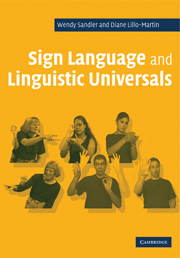Book contents
- Frontmatter
- Contents
- Preface
- Notation conventions
- UNIT I INTRODUCTION
- UNIT II MORPHOLOGY
- UNIT III PHONOLOGY
- 8 Meaningless linguistic elements and how they pattern
- 9 Sequentiality and simultaneity in sign language phonology
- 10 Hand configuration
- 11 Location: feature content and segmental status
- 12 The non-dominant hand in the sign language lexicon
- 13 Movement
- 14 Is there a syllable in sign language?
- 15 Prosody
- 16 Phonology: theoretical implications
- UNIT IV SYNTAX
- UNIT V MODALITY
- References
- Index
15 - Prosody
Published online by Cambridge University Press: 05 June 2012
- Frontmatter
- Contents
- Preface
- Notation conventions
- UNIT I INTRODUCTION
- UNIT II MORPHOLOGY
- UNIT III PHONOLOGY
- 8 Meaningless linguistic elements and how they pattern
- 9 Sequentiality and simultaneity in sign language phonology
- 10 Hand configuration
- 11 Location: feature content and segmental status
- 12 The non-dominant hand in the sign language lexicon
- 13 Movement
- 14 Is there a syllable in sign language?
- 15 Prosody
- 16 Phonology: theoretical implications
- UNIT IV SYNTAX
- UNIT V MODALITY
- References
- Index
Summary
In spoken language, the flow of speech is not a steady unbroken stream, nor is it uttered monotonally. Instead, it is broken up into rhythmic chunks; some of its elements are more prominent than others; and it is characterized by meaningful excursions of pitch, called intonational tunes. This prosodic pattern is such an integral and systematic part of language that it enables newborn babies to notice when a speaker changes from one language to another, even when the segmental information is filtered out of the signal, leaving only prosodic properties (Mehler, Jusczyk, Lamberz, Halsted, Bertoncini, Amiel-Tison 1988). We intend to show that central properties of the prosodic system are common to languages in both modalities, spoken and signed.
Prosody is often thought of as an area of phonology, and that is understandable, under the broad definition of the term phonology proposed in Chapter 8: phonology is the level of linguistic structure that organizes the medium through which language is transmitted. This broader definition implies that the realm of phonology includes material above the word as well, encompassing, for example, the phrase, the utterance, or even the discourse. However, many linguists maintain that prosody comprises a separate component of the grammar, independent of other levels of linguistic analysis, because it has units and rules for their distribution and combination that are specific to the prosodic component. This prosodic component systematically interacts with all other components – with phonology, syntax, semantics, discourse, and pragmatics.
- Type
- Chapter
- Information
- Sign Language and Linguistic Universals , pp. 246 - 265Publisher: Cambridge University PressPrint publication year: 2006



